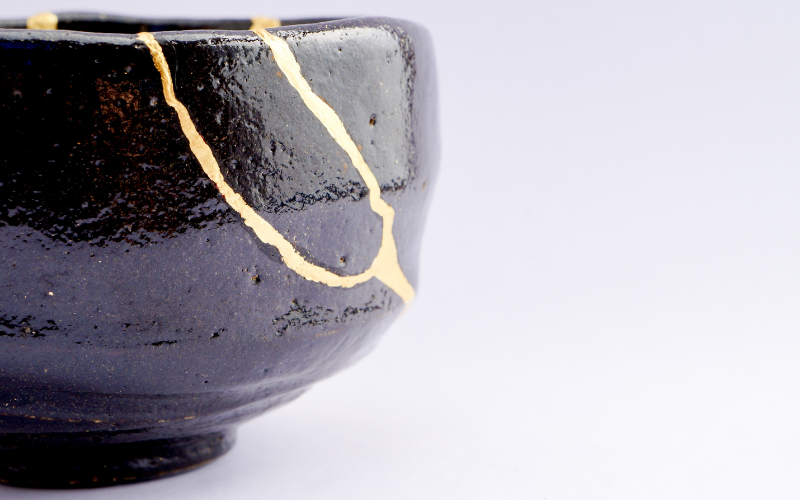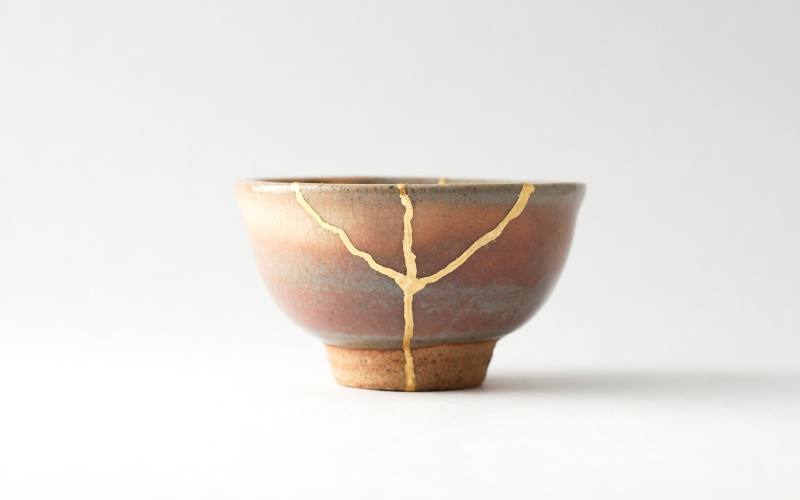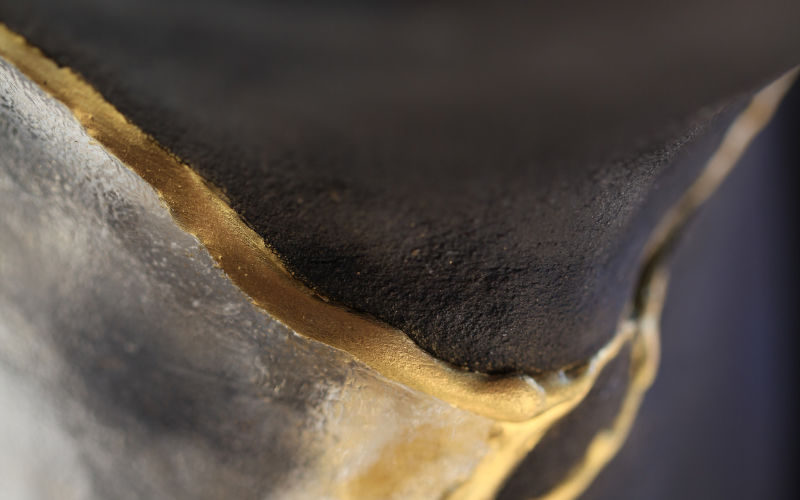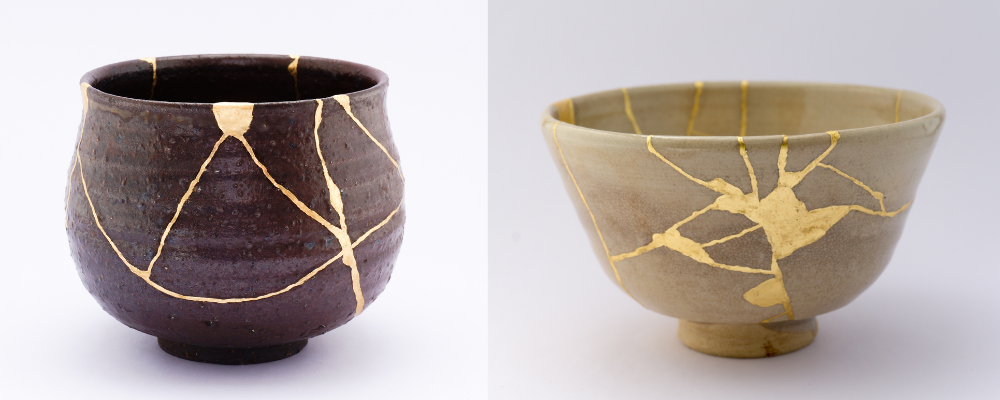It is practically human nature at this point that once we drop something and it shatters into pieces, we immediately throw it away.
And the same goes with our own pottery pieces; once it slips from our hands and breaks, we regretfully throw it in the trash—whether it be a newly made piece or an antique one.
But did you know that there is a type of approach wherein you mend all the broken pieces together into something new – and maybe even better?
What is Kintsugi Pottery?

Kintsugi is a traditional Japanese art of gluing shattered pottery pieces back together with liquid gold. This form of art literally translates to “to join with gold” with Kin meaning golden, and Tsugi meaning joinery.
However, modern methods have also incorporated liquid silver or lacquer, copper, and bronze in their pieces. Through this, beautiful seams of gold shine in the visible fractures of each ceramic, giving each “repaired” piece a personal touch.
This form of art is built on the Japanese principle known as wabi-sabi—a practice where you find beauty in all aspects of nature’s imperfections. Kintsugi encourages the ideology to individuals that there is nothing wrong with exposing their faults and flaws.
In pottery, the Kintsugi practice emphasizes the cracks and breaks in each pottery piece rather than covering or concealing them. More often than not, the Kintsugi art makes the “repaired” object more attractive and meaningful than its original state, rejuvenating it with a new appearance and giving it a new story to tell.
A Brief History of Kintsugi

The origins of Kintsugi are claimed to date back to the Muromachi period wherein the Shogun of Japan, Ashikaga Yoshimitsu, broke his favorite chawan or tea bowl.
He then sent it to be repaired to China but was displeased when it was returned to him mended with unpleasant metal staples. This encouraged his craftsmen to create an alternative that is more aesthetically pleasing.
They focused not on hiding the cracks but on creating something new out of them. Thus, Kintsugi was born.
Methods of Kintsugi

The traditional Kintsugi method uses urushi lacquer which is from the sap of a tree along with powdered gold. The Japanese also often use rice flour in the mix to bind the ceramics together.
This practice also encourages previous craftsmen to work with nature and create something new with what they already have. In modern times, however, materials are less toxic and inexpensive.
Before starting, it is best to know the three methods of Kintsugi: Crack, Piece method, and Joint-call.
Crack
This is the most commonly used method in Kintsugi. It simply uses golden adhesive to reassemble the pieces together.
The end product will highlight its cracks while looking like shimmering veins that are eye-catching.
Piece Method
Also called the Makienaoshi method, this technique mainly uses epoxy. When a piece of several shattered parts is beyond repair, epoxy is used to replace these pieces.
Joint-Call
This technique is the most challenging yet fun method. You get pieces of two broken ceramics and combine them to make one end product.
However, the challenge here is that you have to find broken fragments that fit together. For parts that are nearly fit, you can cement the remaining space with gold just as you would using the Crack method.
The whole process usually takes up to two to three months since the layer of lacquer must be completely dried or hardened before embellishing it with gold or silver.
How do you make Kintsugi pottery?

Kintsugi pottery is fairly straightforward with its methods which makes it perfect for beginners. With that said, you will only need the following materials:
- Broken ceramic objects
- Clear epoxy resin adhesive or other ceramic adhesives
- Gold mica powder
- Wooden craft sticks (popsicle sticks would do just fine)
- A working surface
- Scalpel (optional)
Step 1: Choose the ceramic you wish to “repair”. Make sure the ceramic pieces are clean and dry. Arrange which pieces go where then determine which Kintsugi method to use. If you are going to do the Joint-call method, you will have to get another broken ceramic.
Step 2: To attach the pieces together, use your wooden craft stick to mix equal parts of epoxy resin and gold mica powder on a small container. If you are using liquid gold instead of mica powder, then you will only need to use epoxy resin. Do note that the mixture will harden very quickly so you will have to be ready to glue the pieces immediately. You may notice that the epoxy resin may seep out slightly. That is completely fine as long as you make sure that it will not drip out.
Step 3: Hold the pieces together until the epoxy hardens—this will only take a few minutes. If you are using liquid gold, you will have to wait until the epoxy or adhesive dries before painting on the seams. Once the pieces are together, place it on a flat surface and let everything set for a few hours (usually up to 8 hours).
Step 4: Once completely set, notice if the resin has excessively seeped out of the cracks. If so, use your scalpel to scrape off the excess layer of resin. Once done, wipe your piece clean and it is now ready to be used or displayed.
Do note that you are not limited to using gold powder or liquid. Depending on the look you are going for, you can also use silver, copper, bronze, or even a mix of all of them.
You do not have to worry about perfection when it comes to the final product. Remember that the Kintsugi practice is all about embracing the beauty of each imperfection and giving each “broken” piece a new story to tell and a second chance at life.
Conclusion
Pottery in general is quite intimidating, especially for beginners. Aside from a set of skills needed, you will have to look for certain materials to work with. However, the beauty of Kintsugi is that you can simply start with what you have.
Are you ready to give the art of Kintsugi a try? If so, then you should start with things that are about to be discarded from your home. It could be broken vases, jars with cracks, and other ceramics. This practice will prevent you from discarding broken things that can still be made into something new.
If you have further questions or any fun experiences with Kintsugi pottery, then feel free to comment below. We can’t wait to hear it!

